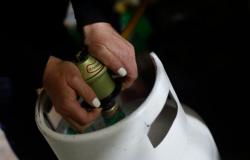Within the framework of National HIV Testing Day, this coming Thursday, June 27, the Ministry of Health will carry out tests to raise awareness and detect the disease. In this sense, HUARPE DIARY He spoke with the head of the Provincial Response Program to HIV, STIs and Viral Hepatitis who said that they target those people who do not have a diagnosis. According to national data, 13% of people are not aware of their diagnosis.
Lorena Herrera, head of the Provincial Response Program to HIV, STIs and Viral Hepatitis explained to HUARPE DIARY At the national level, it is estimated that there are 140,000 people who have HIV and of these, 68% are receiving treatment, 22% know their diagnosis, but are not being medicated, and the remaining 13% are not aware that they have the presentation. “It is that percentage that health policies target with these tests, since they do not know their diagnosis and that they are living with the disease. “Sometimes they don’t have symptoms, they think they haven’t been at risk or they haven’t been encouraged to get tested,” he added.
The alarming percentage is that through testing they seek to ensure that people who suffer from HIV can know their diagnosis and receive treatment on time. In San Juan, 17 people per 100,000 inhabitants are diagnosed with HIV, as confirmed by Herrera.
“Last year there were 144 cases diagnosed in the province. A figure that decreased compared to the year 2022 (152) but its rise is still worrying,” he stated.
According to Herrera, there are currently 800 people in San Juan who are receiving public care for the disease, although there are others who have not continued with treatment and medical consultations.
In this sense, the official commented that not all people who know their HIV diagnosis in the province access treatment for various reasons such as lack of adherence or personal reasons. “We are committed to that as well, in each health center there is monitoring to know the number of patients who are actively withdrawing medication and those who are not,” she explained.
How is the testing
Lorena Herrera explained that the testing is a very simple procedure and does not take more than half an hour. “It is simply a finger prick and the result will be in 30 minutes. In addition, a prior prevention talk will be given,” she said.
On the other hand, he highlighted that through testing they will be able to diagnose new cases and receive treatment in time.
Statistics on gender
Regarding which gender is the maximum carrier, Herrera highlighted that in all diagnosed cases, 68% are men and approximately 30% are women while 1.2% are trans people. “This epidemic has always focused on trans people as the main carriers, but there are many men who are the most risky,” she explained.
The official explained that there are three ways of contracting HIV: through sexual intercourse, blood transfusion and transplacental transmission, which is from mother to baby through pregnancy.
Dangers in pregnancy
Through talks and tests, they also seek to make women aware of the danger at the time of pregnancy and that by not knowing about the presence of HIV in their body, they could infect the baby. “The pregnant woman is detected with HIV, she is treated immediately throughout the gestation period so that the virus does not cross the placenta. In this way there is a 2% chance of that baby being born with the STD,” she said.
Treatment
Although Moreno explained that the treatment depends on the moment the virus is detected, he classified it into three types: pre-exposure medication, before having sex as a way to prevent becoming infected; the medication diagnosed once the virus is detected to suppress the viral load and, finally, there is the PEP medication (post-exposure) that can be taken within three days after a possible exposure to HIV and in emergency cases such as rupture of the preservative.
Lorena Herrera emphasized that “in the desire not to get pregnant and look for contraceptive methods, they forget to use condoms that prevent many infections and diseases that adolescents and young people do not take into account.”
It is worth noting that although the focus is on HIV, the tests can also diagnose STIs such as syphilis, Hepatitis B and C.
Testing locations
- Civic Center: Thursday 6/27 and Friday 6/28 from 9 a.m. to 1 p.m.
- Rawson Hospital: Thursday 6/27 from 8 a.m. to 5 p.m.
- Rizo Esparza Hospital: Thursday 6/27 at 10 informational talk. Testing all day.
- Stella Molina Hospital: Friday 6/28 from 9 a.m. to 12:30 p.m.
- César Aguilar Hospital: Thursday 6/27 and Friday 6/28 from 8 a.m. to 12 p.m.
- Alejandro Albarracín Hospital: week of June 24 to 28 from 7 a.m. to 2 p.m. and 3 p.m. to 7 p.m.
- Federico Cantoni Hospital: Thursday 6/27 and Friday 6/28 from 8 a.m. to 12 p.m.
- Barreal Hospital and CIC Vº Pituill: Thursday 6/27 from 9 a.m. to 1 p.m.
- Giordano Hospital: Friday 6/28 from 9 a.m. to 1 p.m.
- Tomás Perón Hospital: Thursday 6/27 and Friday 6/28 from 8 a.m. to 12 p.m.
- San Roque Hospital: week from 6/24 to 6/28 from 8 a.m. to 12 p.m.
- Marcial Quiroga Hospital: week from 6/24 to 6/28 from 7 to 9.






